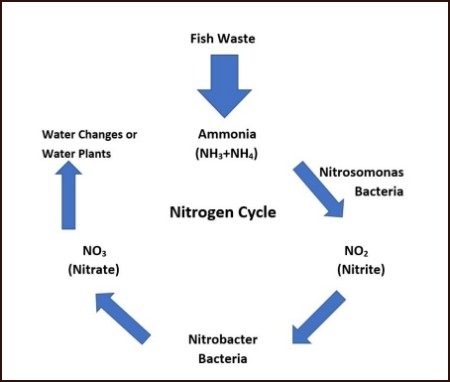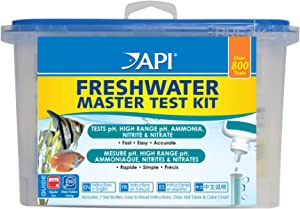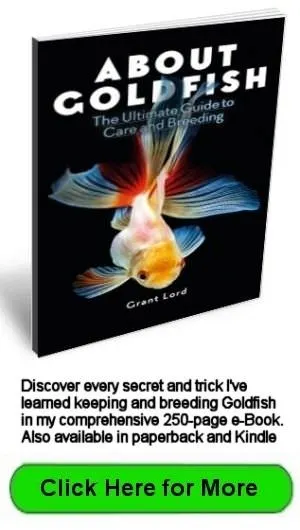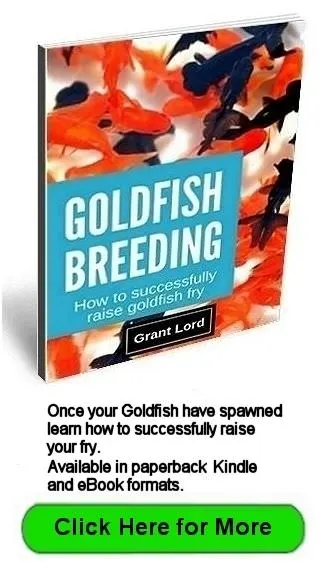Goldfish Aquarium Setup Basics
How and where you set up your Goldfish aquarium affects how much maintenance it will need.

This page is aimed solely at explaining the ideal Goldfish aquarium setup. There are many books and websites that will tell you how to set up an aquarium. Most of the information is fairly generic, but an aquarium should be set up to suit the type of fish that will be living in it.
One size does not fit all.
It is assumed you have an aquarium of the appropriate size for your requirements. If not, or if you are unsure what you have is adequate, go to the page How Much Room Do Goldfish Need? to work that out.
Glass Aquarium Placement
To avoid cracking the bottom pane of a glass aquarium on the first fill the surface it is to be placed on must be flat and level.
This also applies to aquariums that come with their own stands. Check the top is flat and level and doesn’t have any imperfections sticking up such as nails.
Aquariums should come with a square of polystyrene to place under the aquarium. The polystyrene takes up any slight unevenness in the surface.
I also apply this rule to acrylic aquariums even though they take a lot more abuse before they fail.
If the aquarium is a complete package coming with its own stand, place the stand on short tufted carpet or carpet tiles if it is to sit on a hard surface such as a concrete or ceramic tile floor.
Water weighs 10 Lbs a gallon so the weight of the water plus aquarium and gravel can be considerable. Make sure the support structure under the floor can take the weight.
The Importance of Location, Location, Location
There are three rules when deciding where to locate an aquarium:
- Do not place it where it will receive direct sunlight.
- Do not place it near any source of indirect sunlight.
- Do not place it near any source of strong direct or indirect artificial light.
Light is your best friend or worst enemy!
Many aquariums come with good lighting systems which you can adjust for the best balance between optimal light for good plant growth, but not too much to cause excessive algae growth.
If you have a strong light source too close to the aquarium you lose this control.
Because the lighting has to be accurately controlled, the most convenient way to do this is with an inexpensive timer. There are electronic and mechanical timers.
Electronic timers have some advantages over mechanical timers by being able to miss a day altogether or having different hours for different days.
Goldfish Aquarium Gravel
If you intend to have live plants you will need gravel 2 ½" (64mm) deep. The gravel should be smooth and no larger than 1/4" (6mm) for ease of planting, and allow good water circulation to keep the gravel’s aerobic bacteria healthy.
The gravel should be a dark color so that the fish will display good coloration. Light colored gravel tends to make the fish look washed out as they try and adapt their coloration to their surroundings. Some fish become quite nervous with light colored gravel.
WARNING: Goldfish will often choke on gravel. Gravel should either be too large for them to suck up, or small enough so they can easily spit it out. Remember, small fish will grow, so gravel considered too large a few months earlier may become small enough to suck up as they grow larger.
Aerators and Their Problems
Aerators are useful for circulating the aquarium water, thereby exposing more water to the surface and allowing the exchange of gases, oxygen in, carbon dioxide out. To a large extent circulation is achieved by the filter.
There are however a couple of issues with aerators. The first is they are relatively noisy. The majority available have rubber diaphragms driven by an electromagnetic coil that oscillates rapidly. This causes the aerator to vibrate vigorously. If the aerator touches anything it will quickly cause wear on the aerator body, and the surface it is touching.
Another issue is the splashing that occurs when the bubbles rise to the surface and burst. Care must be taken that the droplets of water are able to return to the aquarium. It is a common problem for the droplets to gather on the aquarium cover and then drip off the cover down the side of the aquarium. This can cause considerable damage in a very short space of time, especially if the aquarium stand is made from wood.
Goldfish Aquarium Setup Ornaments
What ornaments, if any, you place in your aquarium depends on the goldfish you are keeping.
As a policy, I don’t place any sharp objects in my aquariums with goldfish that have difficulty seeing, which is all goldfish that don’t have normal eyes. They can easily harm themselves if they get a fright.
For highly developed varieties such as water bubble eyes, the fewer objects in their aquarium the better.
Driftwood looks great, but it tends to color the water brown as it dissolves unless it is genuine hardwood.
Some rocks can dissolve and start affecting the pH of the water. Seashells will do this as well, the dissolving calcium making the water alkaline.
Plants Suitable for a Goldfish Aquarium Setup
Goldfish will eat aquarium plants, especially if they are underfed. There are a few varieties that resist their attack.
As a background plant I use one of the Vallisneria types.
As a foreground plant I use Blue Hygrophila (technically a bog plant) or Red Bacopa.
I use Hygrophila Difformis, Red Hygrophila or Ludwigia Arcuata for creating interest.
Plants should be growing vigorously two weeks after being planted out. If they are not, they have been stressed in transit or storage, or the conditions in the aquarium are not as they should be.
The Bristle Nose Catfish (Ancistrus Temminckii)
You need one small (about 1 ¼”, 32mm) Bristle nose catfish (Ancistrus Temminckii). It will be the most important fish in the goldfish aquarium. It will remove all the brown gunk (diatoms) which will inevitably grow over everything in the aquarium without it. It is sometimes called a Bristle nose Plecostomus which is technically incorrect. It looks like all other Plecostomus when young but does not grow to 12 inches as true Plecostomus do.
They do not eat green or red (brush) algae but you will see them munching on a fresh dead fish as they appreciate the protein source. They also like a piece of cucumber occasionally. This fish, which is a tropical fish, needs a heater. A successful goldfish aquarium setup must have a Bristle Nose catfish and therefore you must have a heater set at 65 degrees Fahrenheit.
Watch for aggressive behavior from the Bristle Nose as some try to get protein by sucking the protective slime from the sides of other fish. If it starts this behavior you will need to exchange it for another.
Setting up the Goldfish Aquarium
Decorate the aquarium to your taste with gravel, plants, driftwood, rocks etc..
Tip:
Don’t just dump the gravel into the aquarium. It tends to ricochet around the aquarium bouncing off the sides. If the aquarium is acrylic, it will tend to mark the acrylic. Even glass aquariums can be damaged. Fill the aquarium with an inch of water to absorb the initial flow of gravel.
Fill the aquarium with water to the appropriate level. Don’t worry if the water is a little cloudy.
Plug everything in and turn it on and check everything is working correctly. Especially check the flows in and out of the filter for leaks or excessive splashing.
Leave everything
running overnight to allow the chlorine in the tap water to gas
off. If your water supplier uses chloramine to disinfect your water supply, you will need to use a water conditioner.
Checking the Setup
The next day check everything is still working properly and the water is up to the correct temperature (65 degrees Fahrenheit). You may see a lot of bubbles attached to the sides, plants and decorations in the aquarium. This is perfectly normal and they will soon disappear.
The Ammonia or Nitrogen Cycle
 The Nitrogen Cycle, also known as the ammonia cycle
The Nitrogen Cycle, also known as the ammonia cycleAny new body of water needs to develop a culture of beneficial bacteria to break down harmful ammonia into less harmful nitrates.
Until the bacterial become established (in the filter), there is a danger of waste producing an ammonia spike.
This is what happens when a new aquarium is loaded with fish. Everything is fine for a week or two, and then suddenly fish start to die for no apparent reason.
Put the Bristle Nose in the aquarium to help mature the filter. Slowly build up the fish numbers over several weeks and use a water test kit to ensure no ammonia is building up.
To speed up the filter maturing process I use API Stress Zyme. It is full of beneficial nitrifying bacteria, so it speeds up the colonization of bacteria, instead of waiting for nature to take its course which can take several weeks.
Purchase a multi-purpose test kit that tests for ammonia and reads the water pH. If you see ammonia building, change 50% of the water and test the next day. If the ammonia is still too high, keep making daily 50% changes until it stops rising.
Tip:
Once the goldfish aquarium is established, use the test kit to work out how often you need to do water changes.
To control algae test the nitrates level. The reading should be no more than 20-30 ppm (parts per million). If it is higher, a partial water change is required.
A drop in pH also indicates a partial water change is required.
The ammonia level shouldn’t be a problem because the filter should be established.
If a large amount of waste accidentally gets into the aquarium such as a fish dying unnoticed or spilled food, test for ammonia over several days.
Now that you have your aquarium setup running, go to the page on Aquarium Cleaning for tips to maintain it with the least possible effort.
Top of Goldfish Aquarium Setup Basics page







